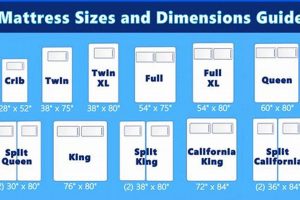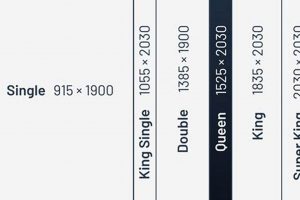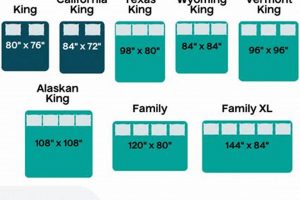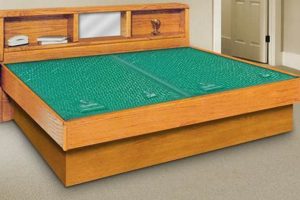The standard size of an inflatable bed designed for a single occupant typically measures around 39 inches in width and 75 inches in length. Height can vary significantly depending on the specific model, ranging from a few inches for a basic model to over 20 inches for a more luxurious or elevated design. These measurements provide ample sleeping space for one individual. For example, a product marketed as “twin” will generally conform to these approximate dimensions.
Conformity to established bed sizes offers several advantages. It ensures compatibility with standard-sized bedding, such as sheets, blankets, and comforters, readily available at most retailers. This eliminates the need for custom-made linens and simplifies the process of outfitting the bed. Moreover, the relatively compact footprint makes it a practical choice for smaller spaces or temporary sleeping arrangements.
Understanding the typical measurements is essential when selecting an inflatable bed to meet specific needs and spatial limitations. The following sections will delve into factors influencing variation in size and discuss considerations for choosing the appropriate model based on intended use.
Considerations for Selecting a Twin Air Mattress
The selection of an appropriate inflatable bed involves careful consideration of several factors beyond the basic dimensions. Evaluating these factors ensures the chosen product aligns with intended use and maximizes user satisfaction.
Tip 1: Assess Available Space: Prior to purchase, accurately measure the intended placement area. Confirm that the inflated product will fit comfortably without obstructing walkways or other essential functionalities of the room.
Tip 2: Evaluate Intended Use: Determine whether the bed will serve as a primary sleeping surface or a temporary accommodation. Regular use warrants investing in a model with enhanced durability and comfort features.
Tip 3: Research Height Considerations: The height of the inflated bed can impact ease of access, particularly for individuals with mobility limitations. Consider a lower profile model for greater accessibility or a raised model for increased comfort and easier ingress/egress.
Tip 4: Review Weight Capacity: Exceeding the manufacturer’s specified weight limit can compromise the integrity of the product and potentially lead to deflation or structural damage. Ensure the chosen model can safely accommodate the intended occupant(s).
Tip 5: Inquire About Inflation/Deflation Mechanisms: Models with built-in pumps offer convenient and rapid inflation and deflation. Consider this feature, especially if frequent setup and takedown are anticipated.
Tip 6: Evaluate Material Quality: The material used in construction impacts both durability and comfort. Thicker, more robust materials are generally more resistant to punctures and provide a more stable sleeping surface.
Tip 7: Check Customer Reviews: Prior to purchase, consult customer reviews to gain insights into real-world performance, durability, and potential issues associated with specific models.
By carefully considering these points, individuals can make an informed decision and select an inflatable bed that effectively meets their specific requirements, ensuring a comfortable and reliable sleeping experience.
The subsequent section will provide a summary of key dimensions and offer guidance on selecting the right bed based on individual needs.
1. Width
The measurement of 39 inches for width constitutes a critical component in defining the overall size specification of an inflatable bed marketed as “twin.” This dimension directly dictates the available lateral sleeping surface for a single occupant. A width deviating significantly from this standard could impact compatibility with standard bedding sizes, potentially necessitating the purchase of custom-fitted sheets and blankets. For example, if an inflatable bed advertises itself as twin size, but its width is actually closer to 36 inches, standard twin sheets might not fit properly, leading to inconvenience and added expense for the consumer.
Maintaining a width of approximately 39 inches ensures the inflatable bed adheres to a widely recognized industry standard. This standardization simplifies the consumer purchasing process by allowing individuals to readily find appropriately sized bedding accessories. Moreover, the relatively narrow width makes the bed suitable for use in smaller spaces, such as guest rooms or dormitories, where space is often at a premium. Conversely, a larger width, while potentially offering increased sleeping comfort, could make the bed unwieldy and difficult to maneuver or store.
In summary, the 39-inch width dimension is not merely an arbitrary measurement; it is a defining characteristic that dictates compatibility, convenience, and spatial efficiency. This dimension’s adherence to established norms provides significant practical advantages to consumers and contributes substantially to the overall utility of the inflatable bed.
2. Length
The dimension of 75 inches in length is a critical component when defining the size of an inflatable bed categorized as twin. This measurement directly affects the suitability of the bed for individuals of varying heights and dictates the available longitudinal sleeping surface. It maintains consistency with established bed sizing standards.
- Accommodation of Adult Height
The 75-inch length is generally designed to comfortably accommodate most adults. Taller individuals might find this dimension restrictive, leading to potential discomfort or the need to seek longer alternatives. The implication for individuals near or exceeding 6 feet in height is that their feet may hang off the edge, disrupting sleep quality.
- Compatibility with Standard Bedding
The consistency of the 75-inch length with conventional twin bed sizes ensures seamless compatibility with standard sheets, blankets, and comforters. This eliminates the necessity for custom bedding, reducing costs and simplifying the purchasing process. Deviation from this length could render standard bedding ill-fitting, requiring alterations or specialized purchases.
- Spatial Efficiency
This length facilitates efficient use of space within smaller rooms, such as guest rooms or dormitories. The compact footprint minimizes the bed’s intrusion into the surrounding environment. Longer beds would demand more floor area, potentially making them unsuitable for confined spaces.
- Impact on Overall Comfort
While primarily dictated by height compatibility, the length contributes to overall comfort. Insufficient length restricts movement and may lead to a cramped feeling, particularly for restless sleepers. Conversely, excessive length offers no additional benefit beyond what is necessary to accommodate the individual’s height.
These facets highlight the critical importance of the 75-inch length in relation to the overall utility and suitability of a twin inflatable bed. The dimension ensures compatibility with standard accessories, optimizes space utilization, and contributes substantially to the sleeping comfort of the individual. Deviations from this standard significantly impact these key aspects.
3. Thickness or Height
The vertical dimension, often referred to as thickness or height, constitutes a crucial factor in determining the overall usability and perceived comfort level of an inflatable bed that is “twin.” It significantly impacts ease of access, overall support, and storage considerations.
- Ease of Access
The height of the bed directly influences how easily an individual can get into and out of it. Lower profile models, typically ranging from 6 to 10 inches, are more accessible for individuals with mobility limitations or children. Conversely, taller models, sometimes exceeding 20 inches, mimic the height of a conventional bed, facilitating easier ingress and egress for adults without mobility concerns. The choice is dictated by the user’s physical capabilities and preferences.
- Support and Comfort
Thickness can correlate with the number and structure of internal air chambers. Higher-profile models often incorporate more sophisticated chamber designs, promoting more even weight distribution and enhanced spinal support. Thin models, while compact, may offer less substantial support, potentially leading to discomfort for some individuals. The layering and internal architecture of the chambers significantly contribute to the overall firmness and conformity of the sleeping surface.
- Storage Volume
While thickness in the inflated state enhances comfort and accessibility, it also influences the overall packed size when deflated. Thicker models generally require more material, resulting in a larger and bulkier package when stored. The inverse is true for thinner models, which offer a more compact storage solution. Consequently, users must balance desired comfort and support with practical storage constraints.
- Aesthetic Considerations
The height contributes to the overall aesthetic appeal of the bed, particularly when used as a temporary or semi-permanent sleeping solution. Higher models often present a more substantial and bed-like appearance, blending more seamlessly with existing furniture. Lower profile options might appear less obtrusive, making them suitable for minimalist decor or spaces with limited headroom.
The interaction between these facets highlights the critical role of vertical dimension in determining the practical application of inflatable beds. The chosen dimension should align with individual requirements, considering factors such as ease of access, required support, storage limitations, and desired aesthetic integration within the intended environment. Selection necessitates a careful balancing of competing factors to maximize user satisfaction.
4. Deflated Size (Storage)
The packed dimensions of an inflatable bed, often referred to as deflated size, are intrinsically linked to its inflated measurements. These deflated measurements dictate storage convenience and portability, factors that are essential considerations during purchase, especially for beds designed for temporary use.
- Material Volume and Compression
The volume of material comprising the bed directly influences the deflated size. Thicker, more durable materials inherently occupy more space, even when compressed. Consequently, high-quality beds often exhibit larger packed sizes than their less robust counterparts. The efficiency of the deflation process, including the ability to expel air completely, also contributes to the achievable packed size. Incomplete deflation leads to bulkier storage, regardless of material volume.
- Folding and Rolling Techniques
The method employed to fold or roll the deflated bed significantly impacts its final dimensions. Consistent and methodical folding techniques result in a more compact package, optimizing storage efficiency. Conversely, haphazard or careless folding creates irregular shapes and increases overall bulk. Some manufacturers provide guidelines or integrated straps to facilitate proper folding and minimize the deflated size.
- Included Storage Accessories
Many inflatable beds are packaged with dedicated storage bags or containers. These accessories are designed to accommodate the deflated bed and associated components, such as pumps and repair kits. The dimensions of these storage accessories effectively define the minimum achievable packed size. Beds lacking dedicated storage solutions often present challenges in achieving a compact and organized storage configuration.
- Pump Integration and Packaging
The presence of an integrated pump, while offering convenience during inflation, can also impact the deflated size. The pump mechanism occupies space, both within the inflated bed and when packed for storage. Similarly, the packaging in which the bed is originally sold influences the initial deflated size. Maintaining this packaging for long-term storage offers a standardized and often space-optimized solution.
These factors emphasize the significance of considering deflated size in conjunction with inflated measurements. A seemingly spacious and comfortable bed may present significant storage challenges if its deflated dimensions are not adequately considered. Consequently, users must balance desired comfort and functionality with practical storage limitations to select a product that effectively meets their specific needs.
5. Weight Capacity
Weight capacity, although not a dimensional measurement in the strict sense, constitutes a critical specification intrinsically linked to the dimensions of a “twin air mattress”. It dictates the maximum load the bed can safely support without compromising its structural integrity or leading to premature failure. The physical dimensions, namely width, length, and thickness, are directly factored into determining this capacity. A larger surface area and greater thickness generally correlate with a higher weight limit, as these attributes enable a more even distribution of the load across the inflatable structure. Exceeding the specified weight capacity places undue stress on the mattress’s seams and internal baffles, potentially causing leaks, deformation, or catastrophic rupture. For instance, a twin-size model designed to support a single adult may be rated for 300 lbs. Attempting to accommodate two adults, even if their combined weight falls below 400 lbs, could still exceed the design parameters and lead to damage due to concentrated pressure points.
The relationship between dimensions and weight capacity extends beyond simple surface area considerations. The internal construction and materials employed also play a significant role. A mattress with reinforced seams and durable, puncture-resistant materials can typically support a higher load than one constructed from lighter, less robust components, even if their external dimensions are identical. Understanding this connection is crucial for making informed purchasing decisions. Consumers should carefully review the manufacturer’s specifications, paying close attention to both the dimensions and the stated weight capacity, to ensure the chosen product is suitable for its intended use. Ignoring the weight capacity rating can lead to safety hazards and costly replacements.
In conclusion, weight capacity serves as a vital safety parameter inextricably linked to the dimensions of an inflatable bed. While the physical dimensions dictate the overall size and sleeping surface, the weight capacity determines the safe operational limits. Neglecting this specification undermines the utility of an inflatable mattress and poses a risk to the user. Consequently, a thorough understanding of this connection is paramount for ensuring both safe and satisfactory usage.
6. Chamber Structure
The internal chamber structure of an inflatable bed directly influences its overall dimensions and performance characteristics. Variations in chamber design affect the distribution of air, the firmness of the sleeping surface, and the overall support provided. Therefore, the internal arrangement is a crucial element to consider when evaluating an inflatable twin bed.
- Longitudinal Chamber Design
Longitudinal chambers, running parallel to the length of the bed, are a common configuration. This design typically provides consistent support along the entire length, often resulting in a more uniform sleeping surface. However, some longitudinal designs may be susceptible to “rolling” if weight is unevenly distributed. A twin-sized bed with longitudinal chambers, for instance, may exhibit sagging if an individual consistently sleeps near one edge. These chambers are constructed from horizontal beams of air from top to bottom to support the weight on the bed.
- Transverse Chamber Design
Transverse chambers, oriented perpendicularly to the length, offer an alternative support system. This arrangement can enhance stability and reduce the likelihood of rolling. Transverse configurations may also provide more targeted support to specific areas of the body. A drawback is the potential for discomfort due to the presence of seams running across the width of the bed. A twin-sized bed with transverse chambers can be folded for storage.
- I-Beam Construction
I-beam construction utilizes vertical supports connecting the top and bottom surfaces of the bed, creating a series of interconnected air chambers. This design enhances structural integrity and distributes weight more evenly. A twin-sized bed employing I-beam construction tends to maintain its shape and firmness, even under significant load. The I-Beams help provide support in the internal chamber.
- Coil Beam Construction
Coil beam construction incorporates cylindrical air chambers that run internally, mimicking the support structure of a traditional coil spring mattress. This design often provides a more comfortable and supportive sleeping surface compared to simpler chamber configurations. In a twin-sized configuration, a coil beam construction aims to provide a more even weight distribution compared to standard I-beam and is great for back support.
In conclusion, the internal chamber structure is not merely an incidental design element. It directly impacts the physical dimensions, comfort level, support characteristics, and overall performance of an inflatable twin bed. Understanding these nuances allows for a more informed purchasing decision, ensuring that the chosen product aligns with individual preferences and specific requirements.
7. Surface Area
Surface area, derived directly from the dimensions of an inflatable bed, fundamentally dictates the usable sleeping space and influences the distribution of weight and pressure. It represents a key consideration when assessing the suitability of a twin model.
- Usable Sleeping Space
The surface area defines the total area available for an individual to occupy. A larger surface area generally offers more freedom of movement and a greater sense of spaciousness. In a twin-sized model, the limited dimensions prioritize compactness, potentially restricting movement for some users. The product of width and length determines this critical area.
- Pressure Distribution
Surface area affects how pressure is distributed across the bed. A larger area, for a given weight, results in lower pressure per unit area. This can enhance comfort and reduce the likelihood of pressure points forming, particularly for individuals with sensitivities. A smaller area, conversely, concentrates pressure, potentially leading to discomfort. Consider, for instance, a model where the twin air mattress is narrow, and it places more weight on a single place.
- Relationship to Weight Capacity
The maximum weight capacity is directly proportional to the surface area and the structural integrity of the materials. A larger surface area can, in theory, support a greater load, assuming the underlying materials are adequately reinforced. However, manufacturers must carefully balance size with material strength to ensure a safe and durable product. The interplay between the dimensions determines the weight limit.
- Impact on Bedding Fit
Surface area, as determined by the length and width, dictates the size of bedding required. Standard twin-sized sheets are designed to fit a specific range of dimensions. Deviations from these standard dimensions, even if slight, can result in ill-fitting bedding, leading to inconvenience and potential discomfort. Uniform dimensions are therefore required to achieve consistent quality of life.
In summary, surface area is a primary characteristic derived from the dimensions of an inflatable bed. It influences the sleeping area, the pressure points, the weight load, the proper size of the sheet. Therefore, evaluating dimensions is crucial in the product evaluation.
Frequently Asked Questions
The following section addresses common inquiries regarding the dimensions of twin air mattresses, providing detailed and informative responses.
Question 1: What constitutes the standard width for a twin air mattress?
The generally accepted width for a twin air mattress is approximately 39 inches. This dimension ensures compatibility with standard twin-sized bedding and allows for efficient use of space in smaller rooms.
Question 2: What is the typical length of a twin air mattress?
A length of 75 inches is considered standard for twin air mattresses. This dimension accommodates most adults comfortably and aligns with standard bedding sizes.
Question 3: How does the thickness or height of a twin air mattress influence its usability?
The thickness impacts ease of access, support, and storage. Thicker models offer increased comfort and support, while thinner models are more compact for storage and easier for individuals with mobility limitations to access.
Question 4: How do the deflated dimensions of a twin air mattress affect storage?
The deflated dimensions directly determine the ease of storage. Smaller deflated dimensions require less storage space, making the mattress more convenient for transport and storage in confined areas.
Question 5: How does the internal chamber structure influence the overall dimensions and performance of a twin air mattress?
The arrangement of internal chambers affects the distribution of air, the firmness of the sleeping surface, and the overall support provided. Different chamber designs can lead to variations in the effective sleeping area and the ability of the mattress to maintain its shape under load.
Question 6: How does surface area, derived from the dimensions of a twin air mattress, impact its functionality?
The surface area dictates the usable sleeping space, influences pressure distribution, and determines the required size of bedding. A larger surface area generally provides more comfort and a more even distribution of weight.
This FAQ section aims to provide clarity regarding the dimensions of twin air mattresses and their implications for usability, storage, and overall performance.
The following section provides a conclusive summary of the key points discussed.
Conclusion
This exposition has thoroughly examined the crucial dimensions of an inflatable bed categorized as “twin.” Specifically, width, length, thickness, deflated dimensions, and internal chamber structure have been analyzed. These dimensional characteristics significantly influence usability, storage practicality, comfort levels, and overall product suitability. Comprehension of these specifications facilitates informed purchasing decisions.
Consideration of these parameters remains essential for both consumers and manufacturers. Prioritizing awareness of dimensional properties ensures a product’s effectiveness, longevity, and user satisfaction. Continued adherence to industry standards and ongoing innovation in design will further refine the utility and appeal of inflatable twin beds in diverse applications.







